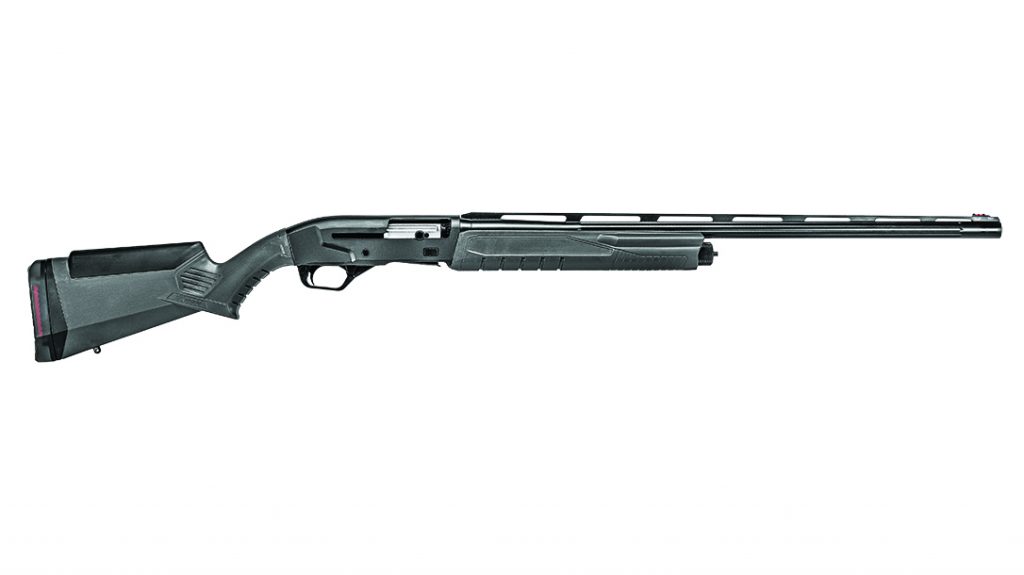The article below on the Savage Renegauge shotgun is from the Oct/Nov 2020 issue of Ballistic Magazine. The print article features an error in the DEK that refers to the Renegauge as “inertia-driven”; however, it is a gas-driven shotgun.
It was 2004 and I had just received one of my first big bonus checks from my employer. Being single, my first thought was, “I should buy a .308 bolt-action rifle that I always wanted.” After weeks of research, I decided to purchase a Savage with the company’s relatively new AccuTrigger. Prior to 2002, Savage hadn’t really moved the needle by providing anything innovative to make them stand out in a flooded marketplace. By 2004, Savage was becoming the bolt gun to have, not only for its trigger, but also for its accuracy and reasonable price. Since then, Savage has always held a special place in my gun collection. When I saw Savage was coming out with a semi-automatic shotgun — the Savage Renegauge — it quickly moved up my list of guns to get my hands on to review.
Savage Repeating Arms Co. was founded in 1894 in Utica, N.Y. It’s hard to imagine in today’s political climate that back in the day the northeastern part of the United States was the gun manufacturing capital of the world. Many iconic brands have their roots in this area, such as Winchester, Colt, Ithaca, O.F. Mossberg, Remington and Marlin (to name a few). Many of these manufacturers helped us win World Wars I and II by making guns for our troops and allies.
Advertisement — Continue Reading Below
Savage Origins
Like so many gun manufacturers, Savage struggled after World War II to stay relevant. In 2013, ATK’s sporting division (now Vista Outdoor) purchased Savage. Being part of Vista’s portfolio of companies (Bushnell, Federal, CCI and more than a dozen others), allowed Savage marketing and booth placement at shows that many companies would envy. However, since Savage was the only gun company Vista owned, it was difficult to really give it the attention it needed to take the brand to the next level.
That’s why Vista put Savage on the market in 2018. Chris Metz, Vista Outdoor CEO, said, “While it was a difficult decision to sell such an iconic brand, I remain confident that this was the correct choice to help Vista Outdoor grow in those categories where we can have leadership positions. Savage is a fantastic business, and it deserves to continue to evolve into other firearms categories.”
To Put their money where their mouth is, Savage’s current management team believed so much in the company that they decided to purchase it from Vista Outdoor for $170 million in July 2019. I see this as meaningful, since many times you see private equity purchases in the gun industry that do little to enhance the brand. They often lead to more recall ads in the back of your favorite gun magazines. I can tell you after talking with the management team at Savage that they are excited for their future. In their own words on the company website, “(Savages are) purpose-built firearms that come out of the box bristling with special features you won’t find from other manufacturers.”
Advertisement — Continue Reading Below
Gas Driven
When it comes to semi-auto shotguns you have two general types: Inertia and gas operated. Inertia is the easiest to make because it uses the force of the fired shell to help eject the spent hull and load the next shell. It’s not too dissimilar from the blowback action of your favorite semi-auto pistol. Inertia shotguns are also easier to clean as they contain the powder fouling in the barrel and bolt area. The downside of inertia is you feel the recoil a little more. Some say another issue with inertia-driven shotguns is that if they are not held tightly to the shoulder, they can fail to eject and load the next round.

In contrast to inertia, gas-operated shotguns function by porting some of the gas from the spent shell (typically under the forend) into a piston that cycles the action. This leads to a softer-shooting gun. However, you also end up with a little more cleaning time under the forend where the gas and unburnt powder can accumulate. The team at Savage chose to go with a gas-driven system. On the Renegauge they call it their D.R.I.V. (Dual Regulating Inline Valve) gas operating system. The claim is that the DRIV system ensures excess gas is vented before it cycles the bolt to eject and load the next round. This system allows for firing low-brass light loads to high-brass magnums with no issues. By having less felt recoil, the shooter is able to stay on target for quicker, more accurate follow-up shots.
Advertisement — Continue Reading Below
Hands On
When the Savage Renegauge arrived at the shop, I was excited to open it up and get a sense of the craftsmanship and how it felt in my hands. With a gun that has a price of $1,449 to $1,549, I won’t let the little things slide like I would on a $500 shotgun. I realize this might be the only shotgun someone ever purchases. If you are going to spend that kind of money, I wouldn’t want you mad at me for not being honest in my review. I’m a big fan of making sure all the touchpoints on a gun feel and function as I would want them to. The forend and the stock were really the only parts that I felt could use a little more attention. The polymer just seemed cheap in comparison with the rest of the finely crafted shotgun.
On semi-auto shotguns, I like to see enlarged bolt releases, prominent charging handles and a wider loading port; the Renegauge has them all. The reason for this is because many shotguns are often heavily used in colder weather; the controls need to be easy to find and function while wearing gloves. It’s also important to me that a shotgun can handle the elements. The Renegauge’s melonite-treated barrel will weather the worst of storms. Additionally, the chrome-lined parts under the forend allow for reduced fouling. Savage boasts you can go 2,000-plus rounds before cleaning.
Savage Renegauge Testing
As far as shooting, the Savage Renegauge handled everything I threw at it. I shot 300-plus low-brass Federal, Winchester, Remington and Herters shells with no issues. I probably shot another 100-plus rounds of slugs, buckshot and even a random bag of shells that had been sitting in my basement for three or four years in a plastic grocery bag. As far as accuracy, I rang a 4-inch gong several times shooting slugs while standing from 50 yards. The Renegauge really was a lot of fun to shoot. Even after all those rounds, my shoulder felt fine. I’m looking forward to the next time I break out the Renegauge for some gun therapy.
Advertisement — Continue Reading Below
The Renegauge has the makings of a shotgun that could become a staple for hunters and sportsmen around the country. Its design can allow for future expansion into the defensive shotgun category if Savage wishes to pursue that market sector. If you’re looking for a reliable shotgun, I strongly encourage you to consider the Renegauge. For more information, visit savagearms.com.
Savage Renegauge Field Specs
- Gauge: 12
- Barrel: 28 inches
- Overall Length: 49.5 inches
- Weight: 7.9 pounds (empty)
- Stock: Synthetic
- Sights: Vent rib, fiber-optic front
- Action: Semi-auto
- Finish: Melonite
- Capacity: 4+1
- MSRP: $1,449 (as tested)
This article is from the Oct/Nov 2020 issue of Ballistic Magazine. Grab a physical or digital subscription at OutdoorGroupStore.com.























